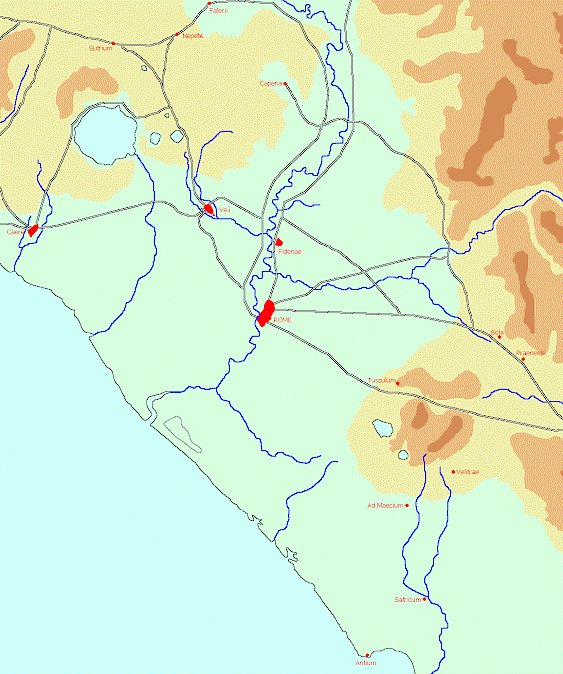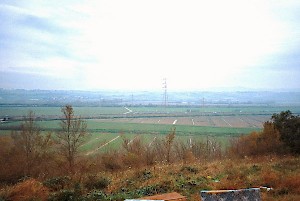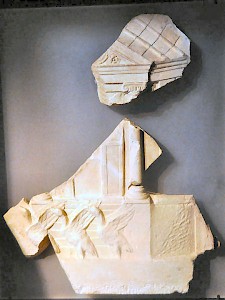Marcus Furius Camillus (3)
Marcus Furius Camillus (c.435-365 VC): Roman general and statesman, captured Veii, annexed Tusculum and put an end to the conflict of the orders. He was called the "second founder" of Rome.
The Gauls

The year after the conquest of Veii, 395 according to the Varronian chronology, the brother of Marcus Furius Camillus, Lucius, was again military tribune with consular powers. His colleagues forced Capena into surrender. Next year, he and Marcus occupied the highest office, and Camillus attacked Falerii. Like Veii, this town was built on a high plateau and a siege would be difficult. Therefore, when the Romans arrived and Faliscans offered terms, Camillus accepted them. Veii's allies were now defeated as well, and this was the end of the Veientine war. Rome had become the most powerful city in Central-Italy.
Almost immediately, disaster struck. In 391, when Lucius was tribune for the seventh and last time, a band of Gallic warriors came to the south. In the last quarter of the fifth century, the Gauls had settled on the plains along the river Po, where they had subjected the native population. Now, they served as mercenaries. Livy's account is full of romantic details, but if we ignore these, we have a plausible story: during a civil struggle in the Etruscan city Clusium, one side invited Gallic mercenaries, and the other side asked Rome -the leading power in the neighborhood- for assistance. The Romans sent three envoys on a fact-finding mission, but the only result was that the Gauls now decided to attack Rome.

In the summer of 390, they reached Latium. At that moment, new men occupied the supreme magistracy, and they led the army to the Allia, a small brook north of Rome. The battle was in fact no battle: when the Roman commanders saw their enemies, they understood that they were no match, and cleared the field. The Roman army was brought to Veii, which now lay more or less deserted. Later historians believed that the defeat had been terrible, but in fact there had probably been hardly any fighting at all.
The date of the battle was remembered as a dies ater ('black day'): 18 July. The Roman lunar calendar was at this moment out of step, so it is not possible to fix the date in our calendar. The Varronian year 390 corresponds with our year 387/386, and the best we can say about the date of the battle is that it took place in the summer of 387.
Rome lay now unprotected, and its inhabitants left the city. They received shelter in Caere, an allied Etruscan town. The Gauls started to besiege the Capitol, which the Romans had garrisoned. One famous incident deserves to be mentioned: on a dark night, the Gauls tried to climb the rocky slopes of the hill. However, the holy geese were awake and warned the Roman soldiers, and a man named Marcus Manlius Capitolinus was able to repel the invaders. In later times, the Romans celebrated this incident on 2 August.

Meanwhile, the main force of the Romans was still in Veii and harassed the Gauls, who must have experienced troubles when they started to look for food. Livy states that Camillus had by now been made dictator and directed the war efforts. It is possible that this is true. However, he was unable to repel the Gauls, and in February 386 BCE, the besieged and the besiegers came to terms: 1,000 Roman pounds of gold were paid, and the Gauls went away. Livy's story that Camillus defeated the enemies when they were marching back is not plausible.
The Roman historians were convinced that the Gauls had destroyed the city, but there is not one single archaeological piece of evidence to support this. And this is only logical, because it would be very strange if the Gauls had burnt down the city in which they were dwelling.
The Roman historian Pompeius Trogus writes in his World history that the Gauls were later serving in the army of Dionysius, the ruler of Syracuse. There is no reason to doubt the truth of his statement, and we may assume that the Gallic mercenaries had entered his service before. It is possible that Dionysius, learning that Rome had conquered Veii, had decided that the city was becoming too powerful, and had sent envoys to the Gauls, inviting them to attack Rome and joining him in southern Italy. This is possible, certainly, but it is also speculative.

Next year (389 V), Camillus was again dictator. The situation was difficult: the Volsci and the Aequi had forgotten that there was a peace treaty, and -even worse- certain Latin towns were on the brink of revolt. It was absolutely necessary that the Romans restored their reputation. Therefore, Camillus marched through Latium to the southeast, where the Volsci lived. In a full-scale battle near Ad Maecium they were defeated, and their camp was burned down. Immediately, he marched to Bola, a town of the Aequi, which he captured. On his return to Rome, the dictator celebrated a triumph.
It was an important victory. Not only had the Romans shown that they were as strong as before, but, more important, they were no longer in the defensive. During the next ten years or so, the Romans infiltrated southern Latium, which was occupied by the Volsci. Ultimately, the reconquest of this region was to destabilize Rome's relation with the other Latin towns.
At this point, Livy tells that the Etruscans suddenly took the Roman city Sutrium. This town was situated in the north of the territory of Veii. Fortunately, Camillus arrived on the same day and recaptured Sutrium.
Livy repeats the story under the year 386, where it probably belongs. In that year, Camillus was military tribune. The truth may be that it was only now that the Romans were able to exercise control in the country they had conquered ten years before. (In 387, it was organized in four districts.) Sutrium, once a possession of Veii, may have become independent in the meantime, but was now subdued. At the same time, the native population of the territories of Veii, Falerii, and Capena received citizenship.
Another event that is mentioned in 386, is a campaign against the Volsci and Latins. They were defeated and the city of Satricum was captured. When Camillus wanted to attack the Volscian capital Antium, he was forced to go to the north to Sutrium - the campaign mentioned in the preceding section. At least, this is what Livy says. It is possible that Camillus in fact had to admit that he could not take the Volscian port.
It has been argued that in these years, the Roman army was reformed. This is indeed possible, but there are no indications in our sources. On the other hand, Rome's continuing military successes after the Gallic catastrophe strongly suggests that the Roman army had become more professional.